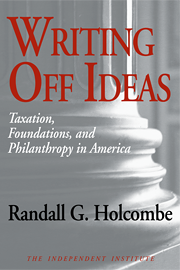One of the most enduring questions in economics is what causes economies to grow. The full title of Adam Smith’s well-known treatise, An Inquiry into the Nature and Causes of the Wealth of Nations, published in 1776, clearly shows that the causes of prosperity were Smith’s primary concern. He concluded that free markets, the protection of private property rights, and a minimal government presence in the economy lead to prosperity. In other words, economic freedom leads to economic growth.
Smith’s conclusions were generally accepted among economists until the twentieth century, when developments in economic theory reversed the conventional wisdom and led economists to advocate central planning and government control as a better way to produce prosperity, especially among less-developed economies. At the end of the twentieth century, economists seem to be turning back to the ideas of Adam Smith. How could they not, especially after the collapse of most centrally planned economies around the world? Yet, driven by abstract economic theory, there still remains a challenge to the idea that laissez-faire policies best promote economic growth.
Adam Smith made the case that prosperity is produced through a competitive market economy. In such a setting, Smith noted in one of his more famous observations, individuals pursuing their own interests are led as if by an invisible hand to do what is best for the whole society. To promote resource allocation in competitive markets, Smith advocated low taxes and government expenditures, the protection of private property rights, and low tariffs to promote international trade. In other words, Smith argued that if a market environment were created and maintained, the economy would grow and prosper.
A few decades later, David Ricardo advocated the lowering of tariffs to promote free trade as a route to prosperity, supporting his arguments with his famous book, Principles of Political Economy, first published in 1817. Ricardo is perhaps best known for showing how everyone ends up better off when people specialize in the activities in which they have a comparative advantage and trade with others. The arguments of Smith, Ricardo, and others brought a reduction in government intervention in Britain and elsewhere, leading to a freer world economy and making the nineteenth century an era of unprecedented economic growth.
Another View on Growth
Although the idea that economic freedom leads to economic growth was not challenged directly, it nonetheless fell by the wayside earlier this century. That was due partly to developments in economic theory and partly to world events. Around the turn of the century, methods in economics began to more closely resemble the hard sciences, especially physics. Economic theory was developed through increasingly complex mathematical models. The economics profession supported those changes, believing that a more scientific understanding of the economy could produce better policies and even more prosperity. In mathematical terms, an economy’s output could be depicted in a production function, where output is a function of inputs such as land, labor, and capital. More inputs produced more output, and the production function was able to show in clear mathematical terms the relationship between inputs and outputs.
When the world was beset by the Great Depression in the 1930s, the development of economics had already traveled far along this path. The National Bureau of Economic Research was established in the 1920s to produce better economic data to allow for more scientific management of the economy. The Keynesian revolution hit economics with the publication of John Maynard Keynes’s The General Theory of Employment, Interest, and Money in 1936. Keynesian economics argued that modern economies need active government policies to manage them and to maintain prosperity. After World War II, those two developments in economics conspired to completely turn around the conventional wisdom on economic growth.
Worried about the possibility of another depression after the war, mainstream economists argued that the government needed to manage the economy in order to maintain prosperity. Economic growth, a significant part of economics since Adam Smith’s day, declined in importance relative to the goal of promoting macroeconomic stability. Growth remained an important issue with regard to less-developed economies, however, and economists believed that they could engineer economic policy to produce growth in those economies in the same way they could do so in the developed world.
The most sophisticated economic models, both then and now, depicted a straightforward mathematical relationship between inputs-land, labor, and capital-and economic output. Thus, economies could grow more rapidly if they increased their inputs. In addition, increased efficiency might allow an economy to produce more output from the same quantity of inputs. Then and now, economists have envisioned increases in efficiency as products of technological advances. The most advanced economies would have to develop better technology through research and development, but less-developed economies may be able to grow simply by adopting the technology of developed economies.
The focus on inputs, coupled with an increasing acceptance of government management of the economy, led economists to recommend government planning as the best way to create growth in less-developed nations. Central planning, they said, could guarantee that economies invested a sufficient share of their incomes, could direct that investment to sectors that would add more value to the economy (for example, away from agriculture and natural resources, and toward manufacturing), and could ensure that the new investment embodied the most advanced technology.
Institutions such as the World Bank and the International Monetary Fund encouraged central planning in less-developed economies and pushed capital investment and adoption of modern technology by offering financial support to less-developed economies headed in that direction. Even in relatively free-market economies like the United States, economic experts supported those types of policies to create economic growth in less-developed nations. Regrettably, the nations that followed such policies did not grow, despite following the advice of the most prominent economists of the time. They would have done better to look back to the advice of Adam Smith.
The Two Views on Growth
Consider in more detail the differences in the two views on growth described above. Both sound plausible, and neither one could really be called wrong, but one view leads to good economic policy and the other leads to bad policy. Why? The twentieth-century approach to growth theory focuses on the inputs of the growth process. If we combine these inputs, it reasons, we will get this output. The Smithian approach looks at the economic environment that is conducive to growth. Following Smith’s line of reasoning, an environment of economic freedom is the key to growth. The problem with the production-function approach is that it ignores the market mechanism that gives people an incentive to combine resources in a way that creates value for others.
Inputs are necessary to produce output, but without the right incentives, it is too easy to combine inputs in a way that makes the final output less valuable than the original inputs. In a market economy we take for granted that production leads to an increase in wealth, because firms that produce output less valuable than their inputs take losses and go out of business. Thus, in a market economy most firms create output more valuable than their inputs. In a centrally planned economy, the government can continue to misdirect inputs into inefficient production arrangements, perhaps not even realizing that resources are being squandered. Policy-makers who designed development policy based on the production-function view of the economy failed to realize that it accurately represented the way that resources were allocated only within the framework of a market economy.
By focusing on the environment conducive to economic growth, the Smithian view pays less attention to inputs. However, Smith also recognized that the invisible hand of the market, if allowed to work within an environment of economic freedom, will do an effective job of allocating resources. Public policy need not be concerned with the production of capital, the incorporation of technology, or the development of a skilled labor force if that conducive environment is created. The economy will attract investment and provide the incentive both for workers to obtain marketable skills and for the adoption of more advanced technology. The right environment will attract the right inputs, but providing the right inputs will not create the right environment. If growth policy focuses on producing an environment of economic freedom, growth will follow. Without the right environment, growth will not occur, period.
Evidence Relating Freedom and Growth
Casual (but persuasive) evidence relating economic freedom and economic growth abounds. After World War II, Korea was divided: South Korea fostered a market-oriented economy, while North Korea maintained a centrally planned economy. As this is being written, many citizens of North Korea are starving because their economy is failing, while South Korea has one of the fastest-growing economies in the world. Similarly, after World War II, Germany was divided into East and West Germany, and again the one with the market economy prospered while the one with the centrally planned economy fell behind. Less than a decade ago, East and West Germany were central players in the cold war that threatened to erupt into World War III. East Germany eventually surrendered to West Germany without a shot being fired, because people in the East wanted to have the advantages offered by West Germany’s economic system.
The former Soviet Union took the production-function model of growth very seriously, so the late empire provides an especially compelling example of the model’s limitations. It invested heavily in physical and human capital, producing a highly trained and educated work force. It also invested heavily in research and development, placing great emphasis on science and engineering. By increasing the quality and quantity of its capital and labor inputs, and creating technological advances, the Soviet Union, according to the production-function approach, should have had one of the world’s fastest-growing economies. Instead, it serves as an example that growth cannot be created by increasing inputs into the production process alone. More inputs lead to an increase in the value of output only when combined within an environment of economic freedom.
In light of their recent prosperity, it is easy to forget that nations like Japan, Taiwan, South Korea, Hong Kong, and Singapore were poor only a few decades ago. Nations that shunned the market system in favor of central economic planning, like the Soviet Union, China, and India, had economies that languished. Now that those formerly socialist countries are moving toward economic freedom, their economies have started to grow. The casual evidence is so clear that there is now a worldwide movement toward more economic freedom. Yet, as compelling as this casual evidence is, it still leaves open the question of what, exactly, the components of economic freedom are, and how much effect they have on economic growth.
A number of recent academic studies have helped shed light on this issue. The most in-depth examination of economic freedom is a study by James Gwartney, Robert Lawson, and Walte Block, Economic Freedom of the World: 1975-1995, published in 1996 by the Fraser Institute. They develop a good numerical measure of economic freedom and show that it is strongly correlated with economic growth. Other academic studies have produced similar results, providing evidence that an environment of economic freedom will attract the inputs necessary to produce economic growth. Those studies examine many other factors, but conclude that the key ingredient is economic freedom. After a century in which the theory of economic growth had moved steadily away from the ideas of Adam Smith, economists are now returning to them to show how economic freedom is vital to prosperity.
Economic Freedom and Political Freedom
After the collapse of the centrally planned economies of eastern Europe in 1989, followed by the demise of the Soviet Union in 1991, most of those nations enthusiastically embraced the principles of Western democracy, hoping political reforms would lead to Western-style prosperity. People in the West offered encouragement, but they supported democratic government more enthusiastically than laissez-faire economic institutions. Thus, it is especially important to understand what is meant by economic freedom as compared to political freedom, and what can be expected from both. While democracy is valuable in its own right, the evidence suggests that democracy by itself makes no contribution to prosperity. Economic freedom produces economic growth; political freedom does not.
This point is especially important in light of the expectations of those in emerging democracies. The citizens of those countries are being set up for a disappointment. If the nations that recently turned to democracy find that their economic conditions are not improving, they may turn their backs on democracy, opening up the opportunity for a return to dictatorship.
The evidence shows that economic freedom leads to economic growth even where countries have limited political freedom. The reverse is not true: political freedom, without economic freedom, does not bring growth. Therefore, it is vitally important that emerging democracies encourage free markets, protect property rights, provide a stable currency, and minimize the government’s role in the economy. There is also evidence that nations with higher incomes tend to be more democratic and more protective of civil liberties and political freedoms. Thus, indirectly, economic freedom leads to political freedom.
The evidence clearly shows that without an environment of economic freedom, growth will not take place. Economic freedom contains a number of components, all of which must be in place for an economy to grow. An economy must have a stable monetary system, secure private property rights, an impartial legal system, low taxes, minimal government, and low barriers to international exchange. If any of these components are missing, an economy will not grow.














